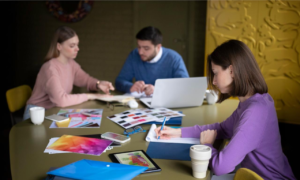Introduction
The debate over whether UI (User Interface) is better than UX (User Experience) often stems from a misunderstanding of their roles in product design. UI focuses on the visual and interactive aspects of a product, while UX ensures the overall journey is seamless and enjoyable. This case study examines how the redesign of FoodieFriend, a restaurant discovery app, highlighted the interplay between UI and UX, demonstrating that both are essential but serve different purposes.
Background
FoodieFriend was popular among food lovers for its vast database of restaurants and user-generated reviews. Despite its popularity, the app faced declining engagement. User feedback indicated frustration with both the app’s usability and its outdated design.
Feedback included:
- Usability Issues (UX):
- Difficulty navigating search results.
- Confusing filter options.
- Unintuitive booking processes.
- Aesthetic Concerns (UI):
- Outdated design elements.
- Overwhelming visual clutter.
The leadership team needed to decide whether to prioritize UX improvements or revamp the UI to modernize the app’s appearance.
Challenges
- Conflicting Priorities:
The design team debated whether focusing on aesthetics (UI) or usability (UX) would yield better results. - Limited Resources:
Budget constraints meant the team had to choose between a complete UI overhaul or addressing core UX pain points first. - User Dissatisfaction:
Both poor UX and outdated UI were contributing to a subpar experience, making it unclear which issue was more critical.
Approach: Prioritizing UX While Enhancing UI
Step 1: User Research and Pain Point Analysis (Focus on UX)
The team conducted:
- Surveys and interviews to understand user frustrations.
- Usability tests to identify where users struggled most.
Key findings:
- The search and filter system caused friction, with users spending excessive time finding relevant results.
- The booking flow had redundant steps, leading to high abandonment rates.
Step 2: Iterative UX Redesign
- Simplified the navigation with clear categories and intuitive icons.
- Redesigned the booking flow, reducing steps from five to three.
- Improved the filter system by adding clear labels and default options for common searches.
Outcome:
Early prototypes showed a 30% reduction in task completion time during usability testing.
Step 3: UI Enhancements for Visual Appeal
- Updated the color palette to reflect modern design trends.
- Replaced cluttered layouts with clean, minimalist designs.
- Introduced consistent typography and scalable icons for a polished look.
Outcome:
The updated design was visually appealing and better aligned with the brand’s youthful audience.
Results
- Improved Usability:
Task completion rates increased by 40%, and user satisfaction scores rose significantly after addressing UX pain points. - Enhanced Visual Appeal:
The modernized UI attracted new users, with a 20% increase in app downloads within three months. - Balanced Investment:
By prioritizing UX improvements first and complementing them with UI updates, FoodieFriend ensured a cohesive experience without overspending. - Business Growth:
The combined changes led to a 25% increase in repeat users and a 15% boost in revenue from bookings.
Conclusion
This case study highlights that UI and UX are not competing priorities but complementary aspects of design. While UX improvements addressed functional pain points and ensured usability, UI enhancements boosted aesthetic appeal and brand perception. In the case of FoodieFriend, the decision to focus on UX first proved critical, as a visually appealing app would not have compensated for poor usability.
Key Takeaway:
UI makes a product look good, but UX ensures it works well. For lasting success, both must be considered as part of a holistic design strategy.


